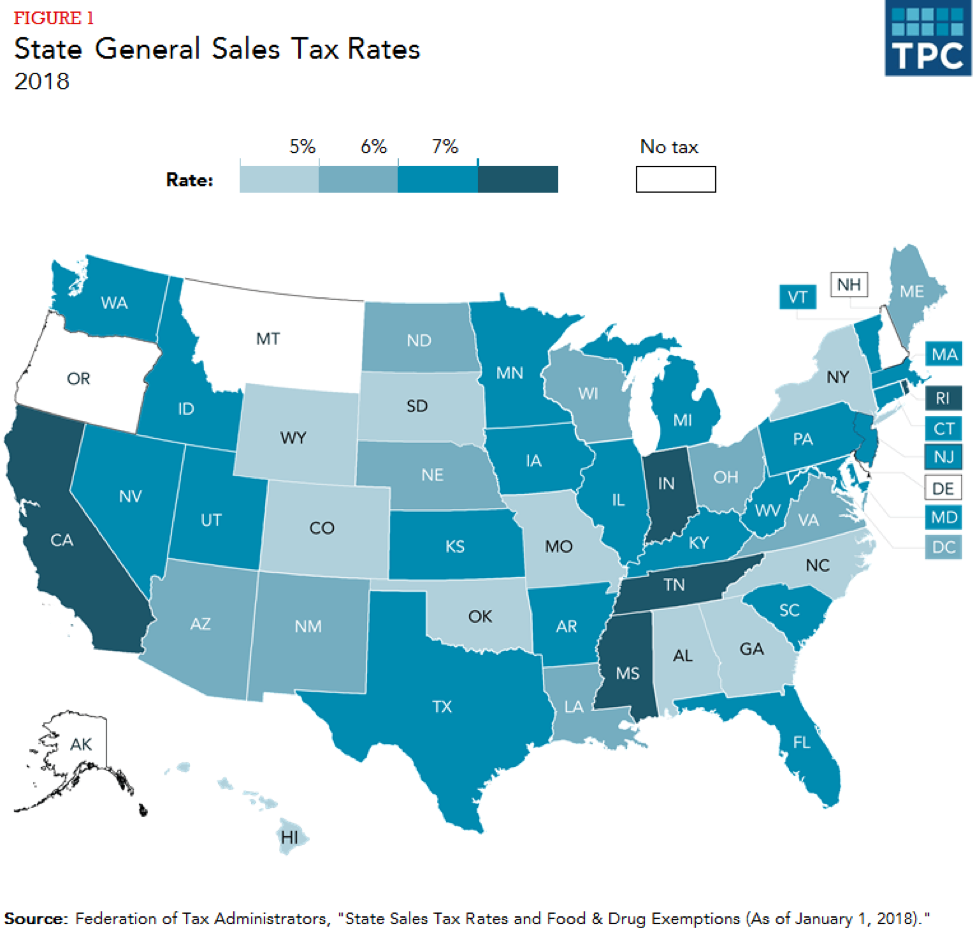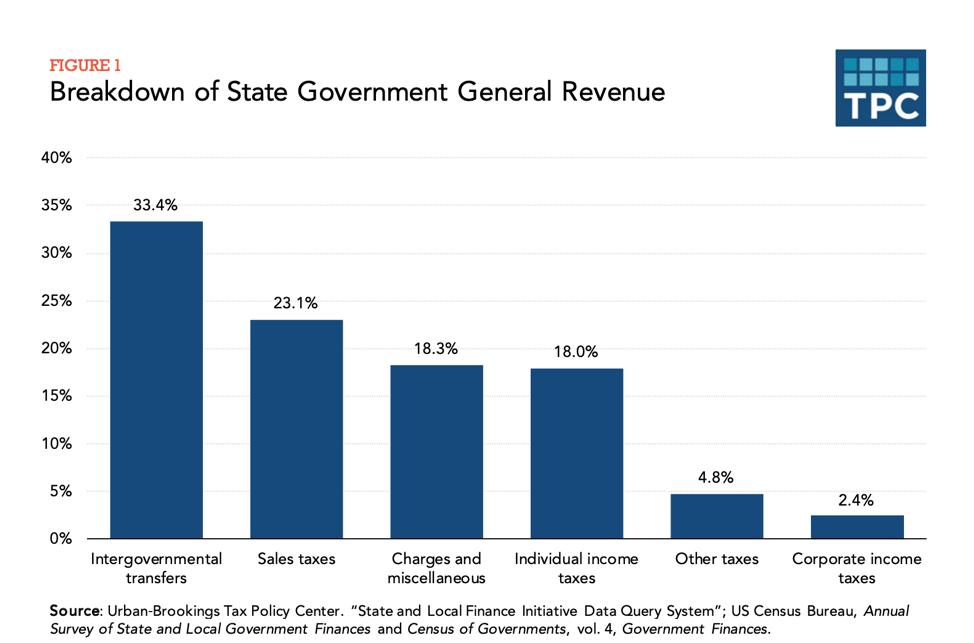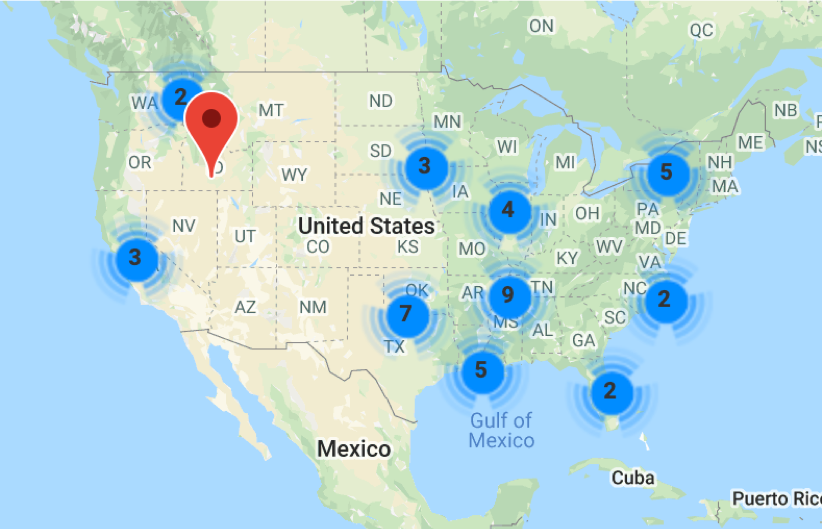 Covering COVID-19 is a daily Poynter briefing about journalism and coronavirus, written by senior faculty Al Tompkins. Sign up here to have it delivered to your inbox every weekday morning.
Covering COVID-19 is a daily Poynter briefing about journalism and coronavirus, written by senior faculty Al Tompkins. Sign up here to have it delivered to your inbox every weekday morning.
You saw the grim national retail sales figures yesterday, down a historic 8.7% in one month. The first reaction is to think about what it means to the retailers. Then comes the reality that retail sales produce retail sales taxes.
Washington, D.C., and 45 states levy sales taxes (here are the current sales tax rates by state). California’s state sales tax is the highest, at 7.25%, followed by Indiana, Mississippi, Rhode Island and Tennessee, which all have a 7% state sales tax rate.
 You can tack on local sales taxes and exemptions to come up with final rates, but you get the idea. It is a big chunk of state budgets. How big?
You can tack on local sales taxes and exemptions to come up with final rates, but you get the idea. It is a big chunk of state budgets. How big?
The Tax Policy Center says about a fourth of state government budgets come from sales taxes:
 Intergovernmental transfers are money that moves from, for example, the federal government to state governments.
Intergovernmental transfers are money that moves from, for example, the federal government to state governments.
You can go to every state’s department of revenue to get a detailed breakdown for your readers/viewers/listeners.
Most state sales taxes come from retail, about two-thirds, the Tax Policy Center estimates. The rest comes from specialized taxes, like state taxes on alcohol and tobacco.
The nine states with no state income tax — Florida, Nevada, New Hampshire, South Dakota, Washington, Wyoming, Texas, Alaska and Tennessee — rely more heavily on sales taxes and property taxes.
The fact is, local governments have seen, or should have seen, the tsunami coming. Cities, counties and states have watched brick and mortar retail sales drop in recent years as we have moved more toward a service economy than a “good” economy. In 2017, The Atlantic observed:
Nationwide, sales taxes comprise nearly one-third of the taxes that state governments collect and about 12% of what local governments collect, according to Lucy Dadayan, a senior researcher at the Nelson A. Rockefeller Institute of Government, a New York-based research group. “The epic closures of the brick-and-mortar stores is troubling news for state and local government sales-tax collections,” she said.
How will this play out locally? The San Diego Union-Tribune reported that local governments throughout the entire region are “staring at sizeable budget deficits.” In California, Proposition 13, which passed in 1978, severely restricts how much local governments can take in from property taxes, so sales taxes became much more important. Mass transit systems in the area, for instance, depend on a half-cent sales tax.
Look at what is unfolding in Haywood County, North Carolina, which has far fewer options to pay for local government services. The county is trying to plan a 2020-2021 budget to begin July 1. Any drop in tourism means sales taxes dry up, too. Some of the communities in that county say they anticipate a tougher economy than they saw even in the 2008-2009 recession.
If there is a worse bet than placing your future on sales tax revenue, it is those states that counted on $50+ per barrel oil prices. The New York Times reported:
Some of the most drastic tax revenue losses have occurred in states like Texas, Oklahoma, Alaska and Louisiana, which rely heavily on taxing oil and gas. Oklahoma based its initial budget projections on $55-a-barrel oil; lately, the price has been less than half that. The Texas Taxpayers and Research Association estimates that for every dollar decline in the price of oil, the state loses $85 million in revenue.
“The things we thought would keep us from hitting the edge of the fiscal cliff — oil prices rebounding, production coming up dramatically — those prospects look awfully dim right now,” Pat Pitney, the Alaska Legislature’s chief budget analyst, who was budget director to former Gov. Bill Walker, recently told the Alaska Public Media news site. “None of us knows the future. But the signs are way less optimistic than they were just a few short months ago.”
Tomorrow, I will look at new estimates of cancellations of hotel rooms and convention businesses and how that is affecting local government budgets and economies. It is really ugly, and it won’t be short-term.
How will you spend your stimulus money?
People say, emphasize “say,” their top priorities for how they will spend their stimulus payments are:
- Saving it (29%)
- Paying mortgage/rent (20%)
- Paying off debt (17%)
- Food and groceries (16%)
- Utility bills (7%)
The loan comparison site Credible said other priorities are, in order of importance, paying medical bills and prescriptions, helping a friend or charity, paying for health insurance, making a car payment, investing in stocks and paying student loans. Coming in last on the list is “take a vacation.”
In 2008, when the government sent stimulus checks of about $950 on average to American households, researchers said “spending at grocery stores was barely affected by the rebate, but consumption at supercenters and other non-grocery outlets increased significantly.” Little of the 2008 rebate went toward clothing and shoes, but almost $100 of it, on average, went toward durable products like electronics, appliances and furniture.
In fact, The Wall Street Journal reported, it appears that the last stimulus checks mostly went right into savings. That research on the 2008 stimulus found, “A third spent most of it within a few weeks and another half spent it within one to three months. Older people were more likely to spend it whereas low-income households didn’t spend more because of the rebate.”
Another study found, “Between 12 and 31% of the stimulus checks went to purchase non-durable goods, with the difference, which varied by household, going to durable goods, primarily automobiles.” That was a big boost to the car industry.
Financial advisors said the best way to use money that you do not need to pay essential debts right away is to put it away in a “rainy day” fund. The rule of thumb from investment advisors is to have an emergency fund that would cover three to six months of expenses, including housing. For a heck of a lot of people, that is a pipe dream.
The next priority, advisors said, is paying down debt, especially credit card debt. Then, the advisors said you can consider investing in stocks that have lost a lot of value in the sudden decline and donating some of the money to a worthy charity or church.
Here comes the stimulus money fraud
If you did not get your stimulus payment yesterday, you are probably getting antsy. Now, the government said it has a way to track your payment. Go to IRS.gov/eip and go to “get my payment” to track your money.
That $2 trillion is a mighty tempting target.
Just look at how many scam alerts the Better Business Bureau is tracking already. Add this huge government bailout on top of it and it will be the scammers’ full employment act before this is settled.
This is a map of stimulus scams already being reported around the country.
To report what you suspect to be a scam, go to this website from the U.S. Treasury Department.
When reporting on the stimulus checks, the first thing to tell the public is, “Most of you do not have to do anything, file anything, or return a phone call to anyone to get your money.” If you filed a 2018 or 2019 tax return you are all set. Most seniors don’t have to do anything either.
Those who did not file a tax return in 2018 or 2019 for whatever reason will need to go here to file a stimulus claim. Just look for the non-filers column on the page.
Those who did file 2018 or 2019 taxes but did not have direct deposit set up and have changed addresses need to go here to update their address.
Those without direct deposit can look for paper checks in May … or it could be later than that. They will be the prime targets for fraud. They need money and fraudsters know it.
And yes, we learned this week that President Donald Trump’s name will appear on the paper checks, the first time a president’s name has appeared on an IRS disbursement.
One thing to keep in mind — the IRS will not call anyone. They mail notices.
There are some predictable scams.
In one, scammers send what seems to be a real check for more than you are due. Then they call you and tell you to send part of that money back. They sent you a fake check and you send them a real one.
The Better Business Bureau ScamTracker said another scam that has already surfaced is social media based. They explained:
You receive a message or see a social media post regarding the COVID-19 economic impact check. You click the link and are taken to what seems to be an official website asking you to enter your personal information and/or banking details. It’s “necessary” to verify your identity and process your check.
The BBB scam alert page also includes this one targeting seniors:
One variation is a Facebook post telling seniors about a special grant to help pay medical bills. The link leads to a website claiming to be a government agency called the “U.S. Emergency Grants Federation” (phony, of course). The site requests your Social Security number under the guise of needing to verify your eligibility. In other versions, scammers claim that you can get additional money — up to $150K in one case — or even receive your funds immediately. All you need to do is share personal details and pay a small “processing fee.”
There is no “early access service.” Scammers are already busy trying to convince people that they have an inside track to faster deposits, which could be really attractive for those who are behind on rent or car payments.
The Secret Service said it is already detecting phishing scams that arrive as email attachments. My journalist friends, I hope you will take some time to explain what phishing is. The Secret Service explained:
In one particular instance, victims have received an email purporting to be from a medical/health organization that included attachments supposedly containing pertinent information regarding the Coronavirus. This led to either unsuspecting victims opening the attachment causing malware to infect their system, or prompting the victim to enter their email login credentials to access the information resulting in harvested login credentials.
The Secret Service also says it is seeing an uptick in the number of social media posts offering stuff for sale that people are desperately trying to find in stores.
Essentially, criminal actors advertise as an in-demand medical supply company that sells medical supplies that can be used to prevent/protect against the Coronavirus. The criminal enterprise will demand upfront payment or initial deposits then abscond with the funds and never complete delivery of the ordered products.
More information on unapproved or counterfeit personal protective equipment can be found at cdc.gov/niosh. You can also find information on the U.S. Food and Drug Administration website (fda.gov) and the Environmental Protection Agency website (epa.gov). Report counterfeit products at ic3.gov and to the National Intellectual Property Rights Coordination Center (iprcenter.gov).
The FBI said scammers will also be offering free or dramatically reduced cost apps, software and downloads that will mine private information without users knowing it.
The FBI said people are also starting to see phishing emails from fraudsters saying they are with an airline and they have information about a refund on unused tickets. The FBI said you might also see realistic looking emails from fake accounts posing as the Centers for Disease Control and Prevention. Do not open such emails, don’t click on links.
Is the U.S. Postal Service in peril?
The COVID-19 pandemic hit the U.S. Postal Service hard.
The USPS said at least 693 postal workers have tested positive for COVID-19 and Americans are mailing much less right now, with offices closed and people communicating electronically at home. Businesses have dramatically cut their mailings.
The American Postal Workers Union president, Mark Dimondstein, said a lot of important stuff moves through the U.S. mail. “In ordinary times, there’s 1.2 billion packages of medicine,” and he said, “just about all” of the Veterans Affairs medicines go through the U.S. Postal Service.
President Trump says he will not go along with a bailout of the post office, which employs 650,000 workers.
The Postal Service is asking for $75 billion in grants and loans. When Congress passed the stimulus package, the Trump administration said if the bill included the $25 billion that the House version of the stimulus plan wanted, the president would not sign the bill. So, the final stimulus bill included a $10 billion line-of-credit.
President Trump said the answer to the postal service’s problems is for the USPS to raise rates. “They have to raise their prices,” Trump said. “Otherwise, they’re just going to lose a lot of money. And tell your Democrat friend that he ought to focus on that, because if he focused on that, he could truly save the post office. The post office has been losing billions of dollars a year for many, many years. And have him take a look at that, because that’s the way to solve the problem.”
Trump has a longstanding disagreement with Amazon, claiming that the postal service loses money delivering packages for Amazon, especially in hard-to-reach areas. That claim, by the way, has been repeatedly fact-checked and found to be false.
Postmaster General Megan Brennan briefed the House Oversight Committee last week and said that by the end of September, the postal service will “run out of cash” unless the government steps in to help. Brennan said since the COVID-19 crisis moved into the U.S., mail volume dropped so much that she expected the virus will cost the postal service at least $13 billion this fiscal year. It has lost about $2 billion a month and, because of the mandate that USPS is an essential government service, the post office has to continue delivering packages, which sometimes contain prescriptions, food and household essentials.
The COVID-19 losses come even as the postal service has had other losses. In fact, last week the postmaster general predicted $54.3 billion additional losses over 10 years.
A key pressure on the Postal Service is a congressional mandate that USPS “pre-fund” health care benefits for retirees even before they retire. While trying to pay for that, the government postal service has delivered 28 billion fewer parcels — which are typically a profit center — over the last 10 years. And we are mailing first-class mail less. First class mail delivery has dropped by 23 billion parcels in the last decade as people use electronic messaging instead.
Fender offers free guitar lessons
The state of the journalism business being what it is, now might be a good time to polish up your second-career skills. Fender is offering three months of free guitar lessons.
The way we work now
My friends at Voice of America sent me this photo of Celia Mendoza, a VOA Spanish Service broadcaster, who produces live remotes from her New York bathroom and broadcasts live to affiliates in Latin America. Notice the shower curtain backdrop. It is Washington, D.C., themed.
At least it is a short distance from the makeup department to the studio.
We’ll be back tomorrow with a new edition of Covering COVID-19. Sign up here to get it delivered right to your inbox.
Al Tompkins is senior faculty at Poynter. He can be reached at atompkins@poynter.org or on Twitter, @atompkins.










